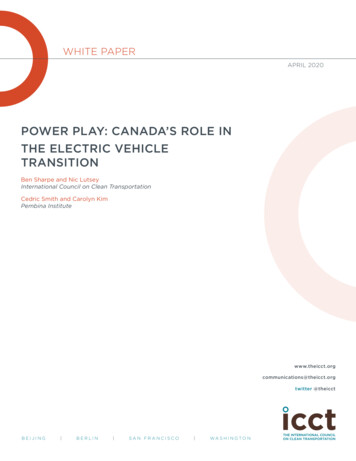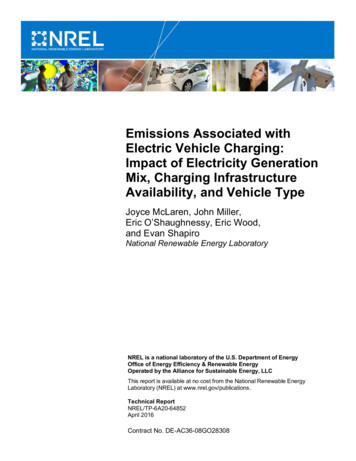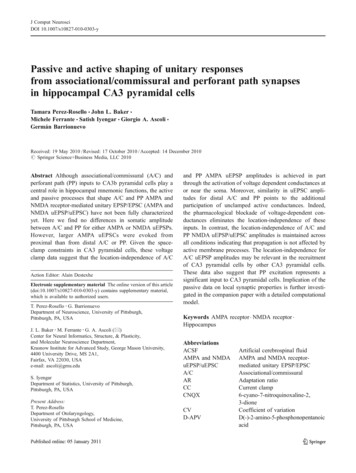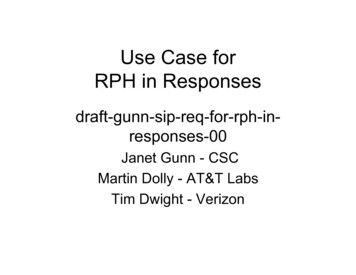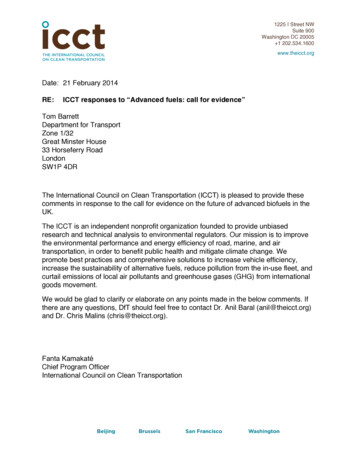
Transcription
1225 I Street NWSuite 900Washington DC 20005 1 202.534.1600www.theicct.orgDate: 21 February 2014RE:ICCT responses to “Advanced fuels: call for evidence”Tom BarrettDepartment for TransportZone 1/32Great Minster House33 Horseferry RoadLondonSW1P 4DRThe International Council on Clean Transportation (ICCT) is pleased to provide thesecomments in response to the call for evidence on the future of advanced biofuels in theUK.The ICCT is an independent nonprofit organization founded to provide unbiasedresearch and technical analysis to environmental regulators. Our mission is to improvethe environmental performance and energy efficiency of road, marine, and airtransportation, in order to benefit public health and mitigate climate change. Wepromote best practices and comprehensive solutions to increase vehicle efficiency,increase the sustainability of alternative fuels, reduce pollution from the in-use fleet, andcurtail emissions of local air pollutants and greenhouse gases (GHG) from internationalgoods movement.We would be glad to clarify or elaborate on any points made in the below comments. Ifthere are any questions, DfT should feel free to contact Dr. Anil Baral (anil@theicct.org)and Dr. Chris Malins (chris@theicct.org).Fanta KamakatéChief Program OfficerInternational Council on Clean Transportation
ICCT Comments onAdvanced fuels: call for evidenceThese comments are in response to the UK’s call for evidence on advanced fuels (DfT,2013a). The background section of these comments provide several high-levelcomments on the prospects for advanced biofuel for transport. These comments arefollowed by specific responses to selected questions (i.e., 1, 2, 3, and 8) in the call forevidence.BackgroundAdvanced biofuels offer great potential in decarbonizing the transport sector on a costeffective and sustainable basis. The transport sector is mostly fueled by high-carbon oilbased fuels, and will be for the foreseeable future. The ICCT see the DfT’s approach ofsimultaneously and proactively pursuing low-carbon advanced renewable biofuels andelectric-drive alternatives as a sound and well-founded long-term climate changemitigation approach. Because electric-drive is limited by the roll-out of vehicletechnology, low-carbon biofuels that can displace petroleum are an attractive near-termalternative. Now, as new commercial advanced biofuels are finally coming on-line, it isthe right time for the UK to strategically promote the role of these fuels in reducing thetransport sector’s climate impact. Given the concern over first generation biofuels due tofood-fuel conflicts, rise in food prices and environmental impacts such as indirect landuse change emissions, the initiative shown by the UK government to focus on advancedfuels is highly commendable. The call for evidence is a timely endeavor to identify thepotential advanced biofuels technologies and appropriate support mechanisms foraccelerating their deployment.Advanced biofuels produced from sustainable biomass feedstocks such as wastes(used cooking oil, municipal solid waste, etc.) and residues (agricultural and forestresidues) have been shown to offer large greenhouse gas (GHG) emission reductionswithout causing significant environmental and resource impacts such as land usechange. A recent ICCT study by Baral and Malins (2014) employs a comprehensive lifecycle analysis (LCA) of advanced biofuels obtained from wastes and residues. Theanalysis, summarized in Figure 1, shows that GHG reductions from such fuels can begreater than 60%, and in some cases exceed 100% when compared against referencepetroleum fuels with a carbon intensity of 83.8 grams of carbon dioxide per megajoule offuel (g CO2e/MJ). The carbon intensities of advanced biofuels from wastes and residuesanalyzed by Baral and Malins (2014) varied from -164 g CO2e/MJ for MSW ethanol to39 g CO2e /MJ for forest slash ethanol. Such significant GHG emission reductions arepossible, even when considering indirect GHG emissions and soil carbon losses fromresidue harvest.2
These findings are similar to the conclusions of earlier work by leading researchers andorganizations (Edwards et al., 2013, USEPA, 2010, ANL, 201, DfT, 2013b) that similarlysuggest that a number of promising non-food-based biofuels can deliver 60% to 100%carbon intensity reductions. However, these studies were not as comprehensive interms of GHG accounting as they generally omit soil carbon loss from residue harvestand/or displacement emissions.120!100!80!% GHG! 60!reduction !40!20!0!Wheat WheatWheatForest Sawdust Sawdust MSWstraw straw FT- strawSlashethanol! pyrolysis ethanol!ethanol! diesel! pyrolysis pyrolysisdiesel!diesel!diesel!Figure 1: Percent GHG savings of advanced biofuels produced from selectedwastes and residues (Source: Baral and Malins, 2014). The column for MSWethanol is truncated because of the high GHG savings (296%) offered throughavoided methane emissions.According to an ICCT study, about 223 million metric tons of wastes and residues aresustainably available in the EU at present (Searle and Malins, 2013). These biomassfeedstocks could in principle produce up to 1 million barrels oil equivalent of advancedbiofuels displacing about 13% of road fuel consumption in 2020, and up to 16% by2030. While there would be practical and economic barriers to 100% utilisation, thissuggests that there is a huge opportunity for climate change mitigation andenvironmental protection via utilization of advanced biofuels in the transport sector.3
As mentioned in the consultation document, advanced biofuel technologies are invarious stages of development and few commercial-scale plants have come intooperation in the US and Europe. Each type of advanced biofuel conversion technologiesfor lignocellulosic feedstocks has unique advantages and challenges as shown in Table1. Research and development efforts are ongoing to improve biofuel yields and costs.These include the use of genetically modified organisms for fermentation of difficult todegrade pentose sugars, improved pretreatments, use of genetically modified biomasswith lower lignin content, etc. It is noted that the projected costs of advanced biofuelproduction have come down considerably in recent years with technologicaladvancements. It has been projected that it may be possible to produce cellulosicbiofuels at the cost of about 0.5/liter using current technologies (Foust & Bratis, 2013).Table 1Technical opportunities and challenges for advanced biofueltechnologiesICCT believes that there are technical challenges as identified in Table 1 as well as themarket barriers that must be overcome to accelerate the deployment of advancedbiofuels, in particular from sustainable feedstocks such as wastes and residues. Hence,government support is crucial in overcoming these barriers and driving the transportsector in a sustainable pathway.Below we provide our responses to some of the key evidence questions posed by theUK Department of Transport.4
1. Should the government focus support for advanced fuels in certain transportsectors? If so, why?We do not see any compelling reasons to differentiate support for advanced biofuelsbetween transport modes. It would seem appropriate therefore to make biofuelincentives equally available to light and heavy-duty vehicles, rail, ships, and aviation,insofar as this is administratively possible. Some biofuel technologies will naturally bebetter suited to specific modes, and allowing fuels to be used in those modes wouldavoid imposing unnecessary extra costs and energy expenditures. Other technologies,in particular drop-in biofuel technologies, will be similar across modes. For instance, thesame processes that would be required to produce jet kerosene would generally beapplicable to producing road diesel, and vice versa.The consultation document states that, “In future, it seems likely that advanced fuels willneed to be used increasingly in sectors which are hard to decarbonise by other means,such as aviation and shipping.” We note that from a resource efficiency perspective,there is no compelling reason to focus on aviation and marine fuels over road fuels inthe near future. As Figure 2 in the consultation documents indicates, the road transportsector is likely still to be using a large volume of fossil fuel by 2040. In that context,given that the lifecycle carbon intensity of road fuel is similar to that of aviation or marinefuel there is no clear environmental benefit from displacing fuel from one mode ratherthan the other. Any technology and infrastructure developed to produce drop-in dieselcould be repurposed in future to prioritise aviation fuel production. Until the road sectorhas been entirely electrified (or otherwise decarbonised), we believe that a level playingfield between modes is the preferable approach to allow resources to be used in theway that delivers the highest carbon savings at the lowest cost.That said, we note that some research has suggested that the use of synthetic fuelscould result in some reduction in the degree of contrail formation by aviation. If it couldbe robustly demonstrated that reduced contrail formation would offer additional climateimpact reduction benefits from using biofuels in the aviation sector, this would representa clear environmental case to consider enhanced support for biofuels in that sector.However, significant additional work would be required to substantiate this result.2. Is UK government support necessary to commercialize advanced fueltechnologies? If so, why?While in the long term advanced fuels offer a cost effective means of decarbonizing thetransport sector, they are mostly in the research and development phase, with only afew cases of commercial production reported to date, and none in the UK. Advancedbiofuel markets are not fully developed yet and hence investors perceive the market andtechnology risk as high. Robust policy support through some combination of utilisationtargets, tax incentives, and direct fiscal support are likely to be necessary preconditionsfor deployment of advanced biofuel production technologies in the UK in the near future.An additional discussion on market risks is provided below in response to question 8.5
2a. What should ‘advanced’ mean? What role should process, feedstock andsustainability have in this definition?In the context of ‘advanced biofuels’, ‘advanced’ should be taken to imply a combinationof new technologies and strong performance on key sustainability metrics. Regulatorymeasures intended to support advanced biofuels should be targeted at fuels derivedfrom non-food feedstocks, using technologies developed to allow the conversion ofmaterials to fuel that cannot currently be readily utilised – in particular cellulose andlignin, as opposed to starches, sugars and oils. In a basket of regulatory measures, itshould be recognised that different fuel pathways will raise different commercialisationchallenges. For instance, the deployment of cellulosic technologies currently requiressupport targeted at raising investment because of high capital expenditurerequirements. The measures necessary to support a cellulosic biofuel industry once thekey technologies have been commercialised will be different than the measures neededto get the first few plants operational, as the investor risk will be substantially diminishedonce the business model has been demonstrated in practice. In the U.S., the ICCT hasproposed temporarily complementing the cellulosic mandate under Renewable FuelStandard (RFS2) with a production-limited investment/production tax credit, available tothe first billion gallons of production capacity and then phased out (Miller et al., 2013).The eligibility criteria for support under different measures may need to be different, sothat appropriate instruments are available for each fuel. For instance, support throughthe Renewable Transport Fuel Obligation has been successful in increasing the use inthe UK of used cooking oil (UCO) biodiesel, which would not meet a technology-focuseddefinition of advanced fuel. It would not be appropriate to include UCO biodiesel in fiscalsupport measures designed for high-capex advanced technology biofuels, but it maywell be appropriate to credit advanced and non-advanced fuels together under amandate. The California Low Carbon Fuel Standard (LCFS), for instance, credits allfuels by carbon performance, thus supporting both advanced technologies and existingtechnologies.In any regulatory measure to support advanced fuels, sustainability criteria will beimportant. Key criteria should be that advanced biofuels would cause little or no indirectland use change, and exert little or no impact on food markets. The UK Governmentshould also consider criteria on soil, water, air, and biodiversity, and on socialsustainability such as land rights and workers’ rights. The RTFO meta-standard remainsa useful guide to key sustainability considerations, but it should be recognised thatmandatory European sustainability criteria under Renewable Energy Directive (RED)are not comprehensive and provide only limited environmental protection.2b. What economic opportunities are there for the UK in developing thisindustry?The economic opportunities provided by the UK advanced fuel industry can besubstantial. In addition to direct job creation at the production facility during constructionand operation phases, jobs will be created indirectly in the supply chains such as6
production, harvest, and transport of feedstocks. Except for MSW, other sustainablebiomass feedstocks will come from rural areas thereby helping the rural economy.According to a recent study by the National Non Food Crop Centre (NNFCC), UK,advanced biofuel production from available wastes and residues in Europe alone wouldgenerate 15 billion of additional revenues for the rural economy and up to 30,000additional jobs would be created by 2030 (NNFCC, 2013).3. What could advanced biofuels deliver, and by when?Advanced biofuels, if produced sustainably from feedstocks such as wastes andresidues can deliver more than 50% of GHG savings, in some cases exceeding 100% ifcredits for avoided emissions are accounted for (see Fig. 1). The timescale todeployment of advanced biofuels will be dictated as much by the efficacy of policysupport as by technological considerations. Without additional support, it is unlikely thatany large number of facilities will be in place in Europe by 2020, but with clear measuresand a framework laid out for post-2020, this could be changed.3a. Do you agree with E4Tech's assessment of the technology readiness ofdifferent advanced fuel technologies?Overall we agree with E4Tech’s technology assessment, which tells us that hydrotreated vegetable oil (VGO), fatty acid methyl ester (FAME) biodiesel, and biogasupgrading technologies have already been commercialised whereas cellulosic ethanoltechnologies are still largely in pilot and demonstration stages with few exceptions.Recently two commercial-scale cellulosic ethanol plants have come online in the USAand Europe. Likewise, various thermochemical conversion technologies such aspyrolysis and gasification are also in pilot and demonstration phases.3b. Do you agree with E4Tech's assessment on the availability of waste andresidue feedstocks, and their estimated costs of advanced fuels?E4tech’s estimates are the total potential supply of waste and residue feedstockswithout taking into account their competing uses. Hence their estimates are on thehigher side. A recent study carried out by ICCT (Searle and Malins, 2013) suggests that225 million metric tonnes (MMT) of wastes and residues are sustainably availableannually for advanced biofuel production in the EU, after excluding wastes and residuescurrently used for other purposes. The availability includes 40 MMT of forest residues,122 MMT of crop residues, and 61 MMT of waste consisting of paper, wood, and foodand garden waste. For the same categories of wastes and residues, the E4Tech studyestimate, which does not protect competing uses, is 521 million tonnes. While theICCT’s estimate of the available resource is somewhat lower than the value given byE4tech, the most important conclusion to draw from both studies is that there is asubstantial resource available, and that resource availability should not be a limitingfactor on advanced biofuel production from wastes and residues in the near to mediumterm.7
8. What support mechanisms could effectively support the deployment ofadvanced fuels?With regard to advanced biofuel technologies, despite their huge potentials there arestories of setbacks such as delays in construction, technological hurdles in scaling upand abandoning of the projects altogether. For example, in 2011, Range Fuels, Inc. wasforced to shutdown after failing to produce the desired advanced biofuel as a result of atechnical problem.To accelerate the commercialisation of advanced biofuel technologies, the industry mustbe enabled to secure the required financing. There are two types of financing: debt andequity. In order to attract either type of financing, it is crucial for firms to establish soundrisk-management practices. Given below are some examples of risks and barriers toinvestment in the advanced biofuel industry. Firm level: Credit (default) risk, price risk, resource availability and supply risk,operational risk Macroeconomic level: Regulatory policy measures, exchange rate risk, interestrate risk, political uncertaintyA recent ICCT study found that the stocks of (U.S. based) companies that are eitherproducing or have significant ownership in cellulosic or algal biofuels are more volatilethan the stock market as whole (Miller et al., 2013). This market risk is likely tocompound the perception of technology risk, and will deter potential investors. Theconsequence is that investors are likely to ask for a higher expected rate of return( 15%) from the first group of advanced biofuel installations than for other less riskyinvestments. The role of government in this picture is to take action to mitigateinvestment risks (such as loan guarantee programs) and/or to provide a higher value ofsupport measures to early market entrants than will be required in the longer term.When considering the value of support measures to companies looking for investment, itis vital that government should consider not only the realised value of support, but itspredictability and reliability from the point of view of those being asked to invest in aplant that will not commence production for two years or more. An incentive such as atax differential that has a guaranteed value of 25 pence per litre in 2018 will generallyhave more value in raising investment than a variable incentive such as an RenewableTransport Fuel Certificate (RTFC) that has an expected value of 25 pence per litre in2018. If fundamental changes to policy are considered possible, the value of anincentive may be effectively reduced to zero for the purposes of investment planning –the ICCT has argued (Miller et al. 2013) that this has been the case with the U.S.second generation biofuel producer tax credit, which has to be renewed annually. Forgovernment, the scenario in which tax expenditures have minimal value as a driver ofinvestment but will represent a significant cost if investments happen anyway is theworst of both worlds.8
8a. If government intervention is necessary, should the focus be on ‘market pull’or ‘technology push’?A successful strategy for advanced fuel deployment requires government interventionthat provides both market pull and technology push. Government grants for researchand development and credits like investor tax credits/production credits inviteinvestment in advanced fuel technologies creating a technology push. On the otherhand, by implementing feasible mandates and price support, the government can createa market pull to create demand for advanced fuels. Some of the examples of market pullare the mandates already in place such as the RTFO and RED, multiple credits foradvanced biofuels under the RED, and which have already been used by regulatedparties under the RTFO. The fixed price support and rewarding fuels on the basis ofGHG savings as mentioned in the consultation document are other examples of thegovernment mechanisms that can create a demand for advanced fuels. The mostefficient approach to accelerating advanced biofuel deployment is likely to require acombination of a long-term market signal with immediate technology pushing measures.8b.Which of the listed mechanisms would be most effective? What alternativeshave we missed?Four options for policy support are identified in the consultation: A sub-target Fixed-price support Multiple certificates within a supply obligation A carbon-linked supply obligationA sub-target for advanced biofuels under the broader RED framework would provide aclear market, and an expected value of support in excess of the value of ‘standard’RTFCs. The two primary challenges to a sub-target would be setting the appropriatelevel (to provide robust market pull while at the same time remaining achievable) andhelping industry understand the likely value of the incentive. It might be appropriate toprovide a buy-out option within a sub-target to provide clarity about the consequences ofa period in which the fuel supply falls short of the mandate. Multiple certificates shouldprovide a similar value signal to a sub-target, of course dependent on the level ofmultiple counting. Such a scheme similarly suffers from a degree of value uncertainty(the uncertainty in the base certificate value, multiplied proportionately up). Indeed,coupling the value of advanced biofuels to the value of a ‘standard’ certificate injectsanother level of variability for investors to confront when considering projects. On thepositive side, such a system would not share the risk with a sub-target that deploymentof the fuel would be inadequate to meet obligations.Fixed price support would have an advantage over a sub-target in that it would providea relatively well defined value signal to producers, but as the consultation notes pricesetting may be challenging. For a smaller initial volume of fuel, it might be acceptable to9
set a relatively high fixed price for a defined period/production volume. As such a pricearrangement could become expensive for larger volumes, a transition could then beplanned towards a mandate system better suited to a more established industry.Finally, a carbon-linked supply obligation would have the advantage of beingperformance based in principle, and therefore in an ideal system would provide the bestvalue possible carbon savings. One issue is the question of carbon accounting – withoutsome allocation of indirect emissions to existing fuels (e.g. iLUC factors), advancedfuels could be under rewarded. A second is, again, the fact that advanced biofuels needsignificant upfront capital investment. Because of value uncertainty of any carboncredits, investors would likely discount the expected value. In contrast, existing facilitiesadjusting production levels would have (more or less) immediate access to thecertificate value. This is likely to make such support less valuable to advancedtechnology fuel producers than to existing ones. Again, it might therefore be appropriateto consider complementary measures to drive initial commercialisation.An alternative not discussed in the DfT document are tax credit schemes such asinvestor tax credits and production tax credits, which can be equally useful drivers,especially in the early stage of commercialisation. As mentioned above, we describeseveral such-fiscal mechanisms in our US-focused report (Miller et al., 2013), and theseconcepts could be adapted to the UK context.8d. Are you aware of any risks, problems or unintended consequences whichcould arise from introducing these market mechanisms?In any system, setting appropriate criteria for eligibility will be important to preventingpoor outcomes and maximising good ones. For instance, any multiple crediting shouldconsider the GHG mitigation potential of wastes and residues as determined bycomprehensive life cycle analysis, including potentially important emissions not includedin the RED LCA. (cf. Baral and Malins, 2014). Even wastes and residues can havesubstantial indirect emissions if they have other existing uses, hence their GHG savingscan be lower in certain cases.10
ReferencesArgonne National Lab (2013). GREET 1 2013. Available at http://greet.es.anl.gov/Baral, A., Malins, C. (2014). Assessing the Climate Mitigation Potential of BiofuelsDerived from Residues and Wastes in the European Context. White paper,Washington DC: International Council on Clean Transportation. Available cations/ICCT biofuels wastesresidues 20140130.pdfDepartment for Transport (DfT) (2013a). Advanced fuels: call for evidence. Available oads/attachment pdfDepartment for Transport (DfT) (2013b).Biofuels carbon calculator (version 6). Availableat s-carbon-calculator.Edwards, R., Larivé, J-F, Rickeard, D., Weindorf, W. (2013). Well-To-Wheels Analysisof Future Automotive Fuels and Powertrains In the European Context. Well-totank report version 4.0. Available at c/files/documents/report 2013/wtt report v4 july 2013 final.pdfFoust, T. &, Bratis, A. (2013). Review of Recent Pilot Scale Cellulosic EthanolDemonstration. Presented at Biomass 2013, Washington DC, July 13, 3 foust op-1.pdfMiller, N., Christensen, A., Park, J.E., Baral, A., Malins, C., & Searle, S. (2013).Measuring and Addressing Investment Risk in the Second Generation BiofuelsIndustry. White paper, Washington DC: International Council on CleanTransportation. Available cations/ICCT AdvancedBiofuelsInvestmentRisk Dec2013.pdfNNFCC (2013). Use of sustainably-sourced residue and waste streams for biofuelproduction in the European Union: rural economic impacts and potential for jobcreation,. UK: NNFCC. Available at mpacts-and-potential-for-jobcreationSearle, S. & Malins, C. (2013). Availability of cellulosic residues and wastes in the EU.White paper, Washington DC: International Council on Clean t/files/publications/ICCT EUcellulosic-wasteresidues 20131022.pdfUSEPA (2010). Renewable Fuel Standard Program (RFS2): Regulatory ImpactAnalysis. Assessment and Standards Division, Office of Transportation and AirQuality, U.S. Environmental Protection Agency. Available .pdf11
the UK of used cooking oil (UCO) biodiesel, which would not meet a technology-focused definition of advanced fuel. It would not be appropriate to include UCO biodiesel in fiscal support measures designed for high-capex advanced technology biofuels, but it may well be appropriate to credit advanced and non-advanced fuels together under a mandate.


